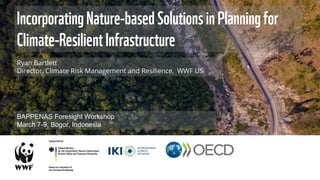
Session 6: Mainstreaming resilience in projects - Ryan Bartlett - WWF
- 1. Ryan Bartlett Director, Climate Risk Management and Resilience, WWF US IncorporatingNature-basedSolutionsinPlanningfor Climate-ResilientInfrastructure BAPPENAS Foresight Workshop March 7-9, Bogor, Indonesia
- 5. 25M km of new paved roads anticipated by 2050, mainly in the tropics (600x around the planet)
- 6. "Planned transport projects include…2650 km of new roads, including at least 1000 km of new toll roads; the establishment of 15 new airports and 24 seaports; and the building of 3258 km of rail lines.”
- 8. Non-startionarity (climate change) renders old planning standards obsolete
- 9. GOAL#3 CONCEPT DESIGN FUNDING APPROVALS CONSTRUCTION GOAL#2 CONCEPT DESIGN FUNDING APPROVALS CONSTRUCTION THECURRENTDEVELOPMENTPROCESS Ecosystemfactorsareconsideredafterkeydecisionshavebeenmade. Isolatedprojectsaredevelopedindependentlyofoneanother. Someprojectsare screenedforclimaterisks GOAL#1 CONCEPT DESIGN FUNDING APPROVALS CONSTRUCTION MINIMIZEor REDUCErisksandimpacts MITIGATEremainingrisks andimpacts COMPENSATEor OFFSETresidualimpacts Reduce carbon emissions CONCEPT DESIGN
- 11. A BETTERDEVELOPMENTPROCESS Ecosystemandclimatefactorsareconsideredin upstreamplanning. Integratedsystems activelyleverageandstrengthennaturalinfrastructure. ANTICIPATE&AVOIDrisksand impacts MINIMIZEor REDUCErisksandimpacts MITIGATEremainingrisks andimpacts COMPENSATEor OFFSETresidualimpacts
- 12. Maintain and restore forests on hillsides to prevent soil erosion due to increased rainfall use wetlands to protect communities from flooding due to increased heavy rains maintain mangroves to protect coastal communities and development from sea level rise Nature-based solutions for resilience
- 13. “Coastal habitats reduce wave heights between 35 percent and 71 percent, and often are less expensive than coastal structures that provide similar benefits” As much as $250m in annual flood reduction benefits
- 14. Infrastructurebenefitsfromnature • Decreased road or lane closures during flood events. • Reduced road pavement damage. • Reduced damage to bridges. • Reduced erosion of roadway embankments. • Decreased vulnerability to shoreline retreat.
- 15. 15 15 “…this study found that (NBS) could avert more than 40% of the future coastal risk from the combined impacts of climate change, land subsidence, and coastal development. On average, the BCRs of (NBS) projects were estimated at just above 3.5…” - Source: US Army Corps of Engineers (2021) International Guidelines on Natural and Nature- Based Features for Flood Risk Management
- 16. Forests protect bridges by reducing soil erosion
- 19. 3/16/2023 “Limited conversion” Some deforestation around roads and population centers Land use change scenarios
- 20. 3/16/2023 “More conversion” More deforestation around roads and population centers Land use change scenarios
- 21. From WWF 2017. Greening China’s Belt and Road Initiative in Myanmar
- 22. Natural capital and infrastructure Impacts nature Depends on nature
- 24. BUILDING WITH NATURE Indonesia Communities in Central Java are suffering from coastal erosion affecting hundreds of kilometers of coastline due to unsustainable development coupled with the effects of climate change.
- 25. “Over 30 million people in Java are at risk. Conventional interventions weren’t successful. So we created a coalition that would harness nature and the community to heal and restore our environment.” FEGI NURHABNI, MINISTRY OF MARINE AFFAIRS AND FISHERIES Source: Building with Nature, www.wetlands.org
- 26. Source: One Architecture & Urbanism on behalf of Building with Nature Asia
- 27. ● public private partnership under leadership of the Indonesian government, Wetlands International and Ecoshape. ● connect key stakeholders and provide framework to share international expertise and local knowledge on aquaculture, ecosystem services, capacity building and governance. ● Such interdisciplinary collaboration has been essential to the success of the project. Source: One Architecture & Urbanism on behalf of Building with Nature Asia Initiative
- 28. Community Engagement and Capacity building meetings Photo: Kuswantaro, Wetlands International Community Group Monitoring Exercise Photo: Netherlands Enterprise Agency on behalf of Dutch Ministry of Foreign Affairs Source: One Architecture & Urbanism on behalf of Building with Nature Asia Initiative
- 30. KEY PLANNING PRINCIPLES 8 PRINCIPLES THE DEFINE THE NUSANTARA DEVELOPMENT DESIGNED ACCORDING TO NATURE UNITY IN DIVERSITY CONNECTED ACTIVE ACCESSIBLE LOW CARBON EMISSIONS CIRCULAR AND RESILIENT SAFE AND ACCESSIBLE SECURITY AND EFFICIENCY THROUGH TECHNOLOGY ECONOMIC OPPORTUNITIES FOR ALL
- 34. “fragmenting large expanses of intact forest… landscape connectivity across the region will decline sharply (from 89% to 55%) if all imminently planned projects proceed…particularly large impacts on wide- ranging, rare species such as rhinoceros, orangutans, and elephants…developme nts will impact 42 protected areas.”
- 35. Source: Implications of large-scale infrastructure development for biodiversity in Indonesian Borneo. 2022 Biodiversity impact estimation
- 37. DESIGNING A CLIMATE RESILIENT CITY DESIGNED ACCORDING TO NATURE CIRCULAR AND RESILIENT DESIGNING WITH AND FOR NATURE How can the city development and planning process enhance the conservation and protection of ecosystem services PRINCIPLE 1 PRINCIPLE 5 NATURE-BASED SOLUTIONS What will be make IKN truly sustainable and a best-in-class example? ACHIEVING INDONESIA’S SUSTAINABILITY GOALS
- 38. WWF: KEY SUPPORT AREAS Through this programme, WWF is collaboratively working with government partners and key stakeholders through country offices in Indonesia, to improve and guide regional, national, and subnational infrastructure and economic development strategies and planning to meet the critical sustainability and resilience objectives of the Paris Agreement and 2030 Agenda. At a high level, WWF aims to: Conduct preliminary assessment of the landscape of stakeholders and their associated capacities to identify in-country champions Undertake collaborative and participatory spatial assessments of natural capital and ecosystem services Improve capacity for balancing nature-based solutions and engineered approaches in landscape planning Integrate results into project assessment and relevant government mapping and data platforms
- 39. Thankyou
